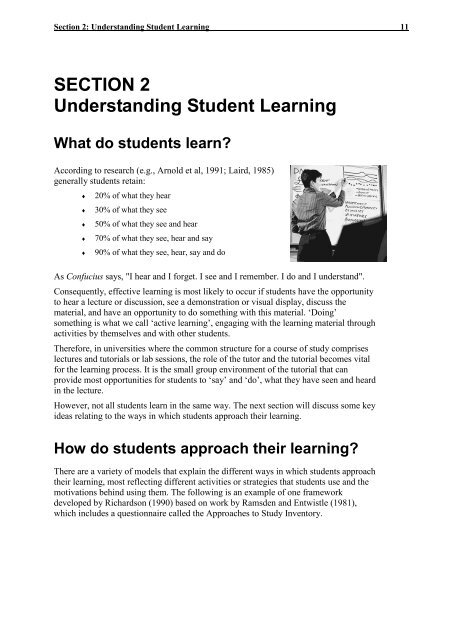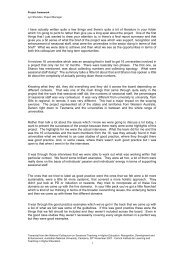A tutor's guide to teaching and learning at UQ - TEDI - University of ...
A tutor's guide to teaching and learning at UQ - TEDI - University of ...
A tutor's guide to teaching and learning at UQ - TEDI - University of ...
Create successful ePaper yourself
Turn your PDF publications into a flip-book with our unique Google optimized e-Paper software.
Section 2: Underst<strong>and</strong>ing Student Learning 11SECTION 2Underst<strong>and</strong>ing Student LearningWh<strong>at</strong> do students learn?According <strong>to</strong> research (e.g., Arnold et al, 1991; Laird, 1985)generally students retain:♦♦♦♦♦20% <strong>of</strong> wh<strong>at</strong> they hear30% <strong>of</strong> wh<strong>at</strong> they see50% <strong>of</strong> wh<strong>at</strong> they see <strong>and</strong> hear70% <strong>of</strong> wh<strong>at</strong> they see, hear <strong>and</strong> say90% <strong>of</strong> wh<strong>at</strong> they see, hear, say <strong>and</strong> doAs Confucius says, "I hear <strong>and</strong> I forget. I see <strong>and</strong> I remember. I do <strong>and</strong> I underst<strong>and</strong>".Consequently, effective <strong>learning</strong> is most likely <strong>to</strong> occur if students have the opportunity<strong>to</strong> hear a lecture or discussion, see a demonstr<strong>at</strong>ion or visual display, discuss them<strong>at</strong>erial, <strong>and</strong> have an opportunity <strong>to</strong> do something with this m<strong>at</strong>erial. ‘Doing’something is wh<strong>at</strong> we call ‘active <strong>learning</strong>’, engaging with the <strong>learning</strong> m<strong>at</strong>erial throughactivities by themselves <strong>and</strong> with other students.Therefore, in universities where the common structure for a course <strong>of</strong> study compriseslectures <strong>and</strong> tu<strong>to</strong>rials or lab sessions, the role <strong>of</strong> the tu<strong>to</strong>r <strong>and</strong> the tu<strong>to</strong>rial becomes vitalfor the <strong>learning</strong> process. It is the small group environment <strong>of</strong> the tu<strong>to</strong>rial th<strong>at</strong> canprovide most opportunities for students <strong>to</strong> ‘say’ <strong>and</strong> ‘do’, wh<strong>at</strong> they have seen <strong>and</strong> heardin the lecture.However, not all students learn in the same way. The next section will discuss some keyideas rel<strong>at</strong>ing <strong>to</strong> the ways in which students approach their <strong>learning</strong>.How do students approach their <strong>learning</strong>?There are a variety <strong>of</strong> models th<strong>at</strong> explain the different ways in which students approachtheir <strong>learning</strong>, most reflecting different activities or str<strong>at</strong>egies th<strong>at</strong> students use <strong>and</strong> themotiv<strong>at</strong>ions behind using them. The following is an example <strong>of</strong> one frameworkdeveloped by Richardson (1990) based on work by Ramsden <strong>and</strong> Entwistle (1981),which includes a questionnaire called the Approaches <strong>to</strong> Study Inven<strong>to</strong>ry.



